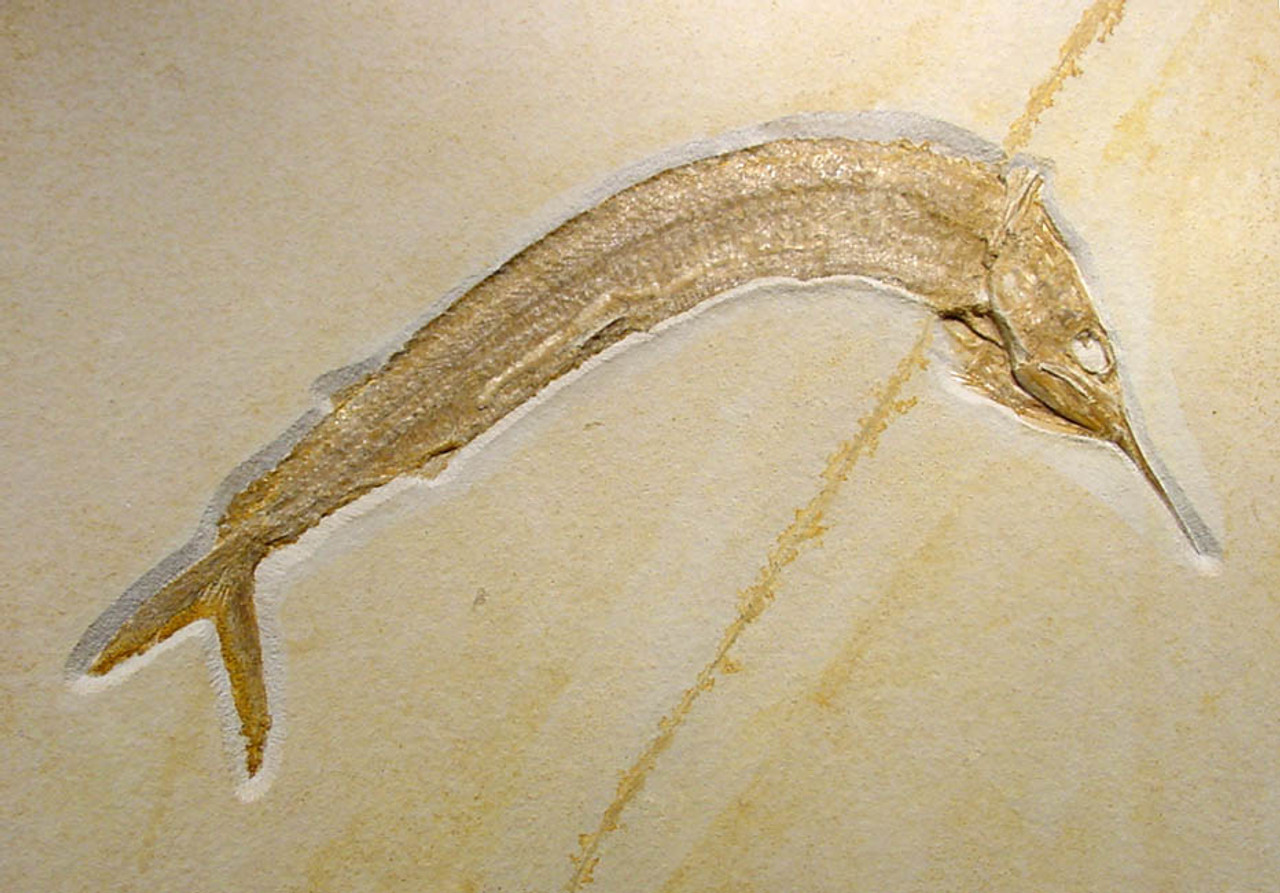Product Description
This is a fossil of the Jurassic fish Aspidorhynchus acutirostris. Specimens like this are very scarce in today's market and most often, when one becomes available, it is from an old collection. This is one of those instances. This rare fish fossil possesses several unique features for its type. First, it is on an unusually large original limestone plate in which it was found. Usually, the rock is trimmed around the fish (especially on old German collection pieces like this one) because the fossil is the focus and carrying such a large plate out of the quarry is troublesome. Second, this fish is in IMPECCABLE preservation - 100% complete and fully preserved in every minute detail with no detracting features. From the complete needle-sharp rostral spine to the tip of the wonderfully detailed tail fins, this Aspidorhynchus is present and fully exposed in a rare semi-3D articulation. The fossil crosses a natural fissure in the rock that split when it was excavated. The coloration of this line running down the center is natural pigmentation from mineralization of the fissure. This same natural mineralization can be seen also on the edges of the rock plate. The natural fissure was put back together and because it was a natural fissure, the split was very thin requiring only minor repair with some fragmentation at the end.
The pose of the fish across this seam is quite attractive, actually and makes the fish appear as if it is jumping up over a barrier. The right side of the head protrudes up off the rock and all the scales and body armor are preserved in a stunning translucent honey yellow tone. 100% COMPLETE possessing the FINEST POSSIBLE PRESERVATION AND DETAIL. Every unique feature of the anatomy of this species can be seen. Most noteworthy and exceptional is the complete array of bizarre rectangular enameloid plate scales that this species possessed, perfectly preserved!
It is important to first emphasize that ALL the detail you see across this entire fish IS GENUINE unlike the many different types and world sources of fish fossils where much of the "fossil" is painted on the rock by skilled artisans.
The limestone slab is heavy with an approximate average thickness of 1". The reverse side has been reinforced with epoxy resin and fiberglass and a wooden brace has been epoxied into the back allowing you the freedom of attaching wall mounting hardware to allow this large slab to be safely hung on a wall that is structurally sound.
SEE MORE FISH FOSSILS
HISTORY
The Aspidorhynchus acutirostris first inhabited the ancient Jurassic seas two hundred million years ago. This fish is a member of an extinct group of bony fishes called Aspidorhynchids (meaning "shield snout"). Key features that set them apart from other teleosts include a very elongated body and snout with large vertically running rectangular scales along the flanks. Surviving from the Early Jurassic to the Eocene Period, Aspidorhynchids were marine dwelling fish that later evolved to tolerate freshwater by the Late Cretaceous. Their long snouts were lined with extremely sharp teeth. Their slender body profile and the fact that the upper jaw bones were immobile preventing the fish from inhaling their prey, suggest that Aspidorhynchus was designed to be a predator, and a quick one at that! Fossil stomach remains of other fish have been found in specimens of Aspidorhynchus. Long and delicate gill rakers indicate that this fish was also able to filter feed to supplement its diet.
Famous for producing an astonishing diversity of rare and most intricately preserved fossils found anywhere in the world, the Jurassic lithographic limestone deposits of southern Germany are legendary. Quarries in the region are privately held and mostly worked by hand on a small scale. The finest grade fossils are few and far between and much rock must be split to locate them. The best fossils are most often kept by the quarry owners who themselves, are often collectors. Some quarries are operated on a large scale but these are now dug with machinery instead of manual labor. Because of this the rock is damaged and along with it, the rare fossils. What all this means today is that even fewer fine grade Solnhofen fossils are found and when they are, rarely do the best pieces make it to market. Occasionally, an old private collection surfaces and specimens are sold or traded. This is where the rare opportunity comes along to acquire a specimen on a level that truly is a prize find. Typically, the older material is often the best as it was collected when the deposits were first being worked and quality was in greater abundance.
 US DOLLAR
US DOLLAR
 EURO
EURO
 AUSTRALIAN DOLLAR
AUSTRALIAN DOLLAR
 CANADIAN DOLLAR
CANADIAN DOLLAR
 POUND STERLING
POUND STERLING












